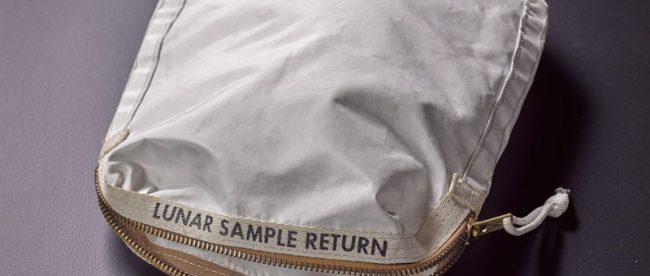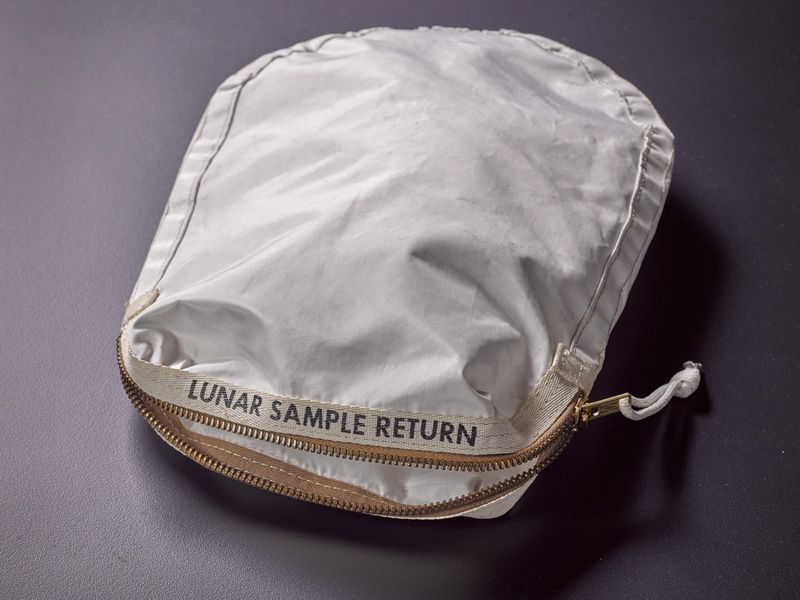How NASA (Almost) Got Its Rock Bag Back

A trip to the moon is expensive — so much so, that we don’t bother doing it anymore. As a result, everything and anything that has been to the lunar surface is particularly valuable. And items that originated on the moon? Incredibly so.
Which is what makes this bag special.

That’s a generic looking bag, sure, but the words give it away: “Lunar Sample Return.” The bag above is the kind and type NASA used on the Apollo missions; astronauts would collect samples from the moon’s surface in these for transport back to Earth. Not all of the sacks made it outside of the lunar lander, but those which did carried back not just minerals, but history. And the one above? It was used by Neil Armstrong to transport samples — it, therefore, contained the first-ever moon rocks to make their way to Earth.
But that bag isn’t in a museum. It was, briefly, but a scam compounded by a mistake got in the way.
Years ago, Max Ary was the director of the Cosmosphere, a space museum in Hutchinson, Kansas. By 2005, though, he was convicted of stealing from the museum’s collection and auctioning them off, keeping the proceeds for himself. Ary was sentenced to three years in prison and had to pay restitution in the amount of $132,000. The bag above, though, was not part of his scam. It was, rather, part of his punishment. Ary also had a significant, and potentially legitimately-acquired, private collection of space artifacts. As the Chicago Tribune reported, “federal government attorneys obtained a court order to sell some of the items recovered from Ary to pay restitution.” And given how special the bag was, it should have easily fetched the $132,000 Ary owed.
Then, the screw-up happened. The bag above was listed for auction — but not as the Apollo 11 bag used by Armstrong. Instead, it was listed as an Apollo 17 bag which never left the spacecraft (well, not while the spacecraft was on the moon, at least). That bag was worth considerably less and fetched only $995 at auction. The winner, Nancy Carlson of Illinois, figured it was a good enough deal, but wanted to make sure she had gotten what she bargained for. After buying the bag, she sent it to NASA for authentication.
NASA told her the truth behind her bag. That was the good news. The bad news? NASA wasn’t about to give it back. As Atlas Obscura reported, “once it was back in the hands of the space agency, NASA decided that is where it belonged.” NASA decided not to return the bag to her, citing its historical significance. Instead, they offered to refund her $995. She, of course, declined — and instead, sued.
The court ruled in her favor, awarding her ownership of the bag, moondust and all. Carlson, though, didn’t feel comfortable keeping the bag — not because of its history, but, she told CBS, because she didn’t think she could keep it safe in her home, given its value. She put it up for auction and on July 20, 2017 — forty-eight years after the bag found its way to the moon — it found its way to a new owner. The price? $1.8 million, of which NASA received nothing.
Bonus fact: Moondust isn’t like earth dust. Because there’s no wind, water, or similar things to wear down the moon’s surface, moondust isn’t soft. Rather, it’s very abrasive — glass-like — and it caused a lot of problems on moon missions. As Phys.org reported, “during the Apollo 17 mission, for example, crewmembers Harrison ‘Jack’ Schmitt and Gene Cernan had trouble moving their arms during moonwalks because dust had gummed up the joints” and even ate through “three layers of Kevlar-type material on Jack’s boot.”
From the Archives: Where No Sandwich has Gone Before: Lunch in space.
Take the Quiz: Name the astronauts who have walked on the Moon.
